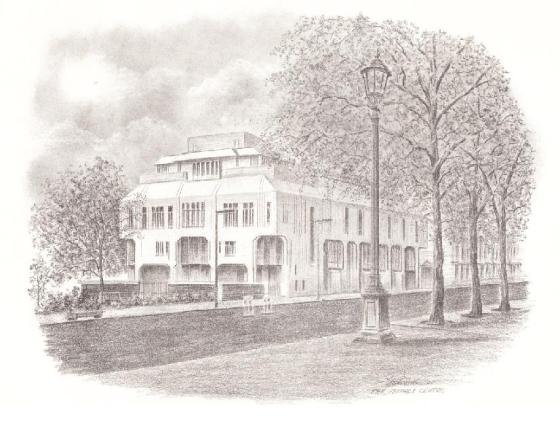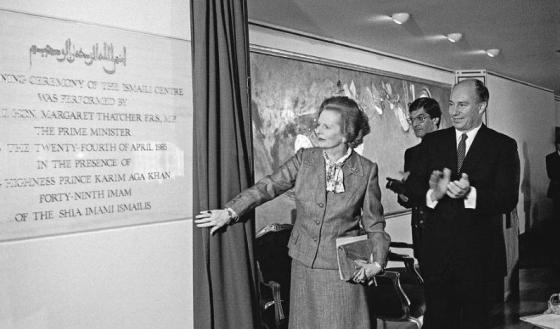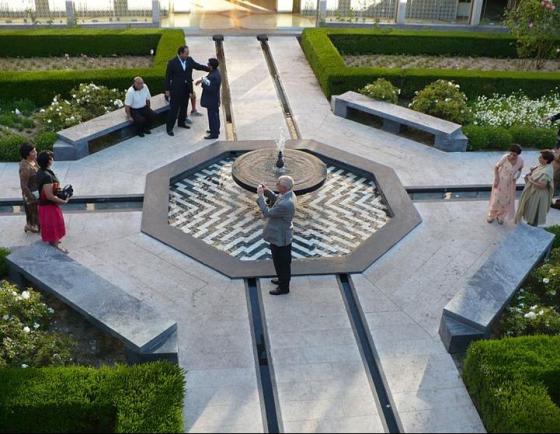ISMAILI SCHOLARSHIP, RESEARCH AND RELIGIOUS EDUCATION FOR THE JAMAT
“Founded in 1977 by H.H. Prince Karim Aga Khan, the Institute of Ismaili Studies in London, UK, functions today as a gathering point for the Ismaili community’s interest in its own history and in its relationship with the larger world of Islamic scholarship and contemporary thought.

His Highness the Aga Khan pictured with Ismaili scholars and leaders of the Ismaili community at the World Ismailia Association Conference held in Paris in April 1975, where a decision was taken to establish an institution for Ismaili Studies. Photo: Ilm magazine, UK, October 1975.
“Its stated mission is…to explore the interaction of religious ideas within the broader aspects of modern life, but to do so with special attention to often neglected fields that contain the intellectual and literary expressions of esoteric Islam, including Shi‘ism in general and Ismailism in particular, in the full richness of their diversity.

His Highness the Aga Khan viewing the five IIS publications specially commissioned in commemoration of the Golden Jubilee of his accession to the Imamat with Professor Azim Nanji, the former director of the Institute of Ismaili Studies, looking on. Photo: The Institute of Ismaili Studies.
“The Institute has a principal objective to serve the Ismaili community. In practice, however, the Institute is not meant to serve the Ismaili community exclusively, but rather to engage representatives of Islamic opinion across the spectrum. A major component of the Institute’s program is concerned with research and publications….namely encouraging the investigation of Islam, Shi‘ism and Ismaili history by both Ismailis and non-Ismailis alike…..Supporting all its programs is the Institute’s Library, which has one of the most valuable and comprehensive collections in the Western world of manuscripts, books and audiovisual materials relating to Ismaili studies in particular…

A sample of Ta'lim series booklets developed by the Institute of Ismaili Studies and used by Ismaili institutions like ITREB to impart religious education to Ismaili children around the world. Photo: The Institute of Ismaili Studies.
“The Institute’s Department of Education produces a range of multimedia teaching and learning materials in eight different languages on religious and cultural education for the Ismaili community (known as Ta’alim) at all educational levels other than for advanced studies in its graduate programs. Drawing upon modern principles of education and curriculum design, these innovative materials are intended to make religious learning a creative and appealing process for young minds, as well as to bridge the gap between religious and secular education”….Dr. Paul E. Walker, excerpted from IIS Overview.

Religious education teachers shown with leadership and staff of the UK Ismailia Association. The photo is from the first part of the 1980's. Photo: Jehangir Merchant collection.
THE ISMAILI JAMAT’S SPIRITUAL AND CULTURAL SPACE: THE JAMATKHANA
THE CONGREGATION-SPACE
The Satagur has arrived,
The sixty-eight shrines
are here,
at home’s threshold,
The Ganges and Jamna
are here full and flowing.
Now he who bathes is purified,
While the wicked
Will stay aloof from the Lord.
Diving in the congregation-pond
Pearls invaluable came in hand.
Guard, guard the jewels:
They’ll grow manifold in worth.
Learning the truth,
Keep it in the heart,
Telling no-one else.
(Translation of verse 1 of Pir Satgur Noor’s ginan, Satagura padhariya tame jagajo, from “A Scent of Sandalwood” by Dr. Aziz Esmail)
SIDHPUR, INDIA

Begum Salimah and Ismaili leaders look on as His Highness the Aga Khan lays the foundation stone of an Ismaili Jamatkhana at Methan, Sidhpur in India on his visit there on January 22, 1978. Photo: Studio La-Bella, Mumbai. Jehangir Merchant Collection.
SINGIDA, TANZANIA

Commemorative Plaque of Service to Ismaili Jamat at the entrance of Singida Jamatkhana. Photo: Mohezin Tejani
DARKHANA JAMATKHANA, KARACHI

A pre-1979 photo of the Ismaili Jamatkhana in the Garden East neighbourhood of Karachi lit for the Navroz celebrations. This Jamatkhana has since been designated as Pakistan's Darkhana. Photo: Jehangir Merchant collection.
DARKHANA JAMATKHANA, LONDON
“The Ismailis are grateful to the British people for their understanding, especially at the time when so many of them arrived as refugees after their expulsion by ex-President Amin from Uganda not so long ago. Ismailis are proud of their reputation for industry and self-help which I think is correct; but none of their achievements, including the new Centre which we shall soon see rising from this ground, would have been possible without the faith and cooperation of their neighbours”…..His Highness the Aga Khan, Foundation Laying Ceremony, September 1979
“It is a very great pleasure for us to welcome you, Madam Prime Minister, and so distinguished a gathering for a ceremony which is a most significant one for the Ismaili community: significant because this is the first cultural and religious centre in the Western world to have been built specifically for the community’s requirements…It is probably true to say that eventually Ismailis, like other groups which have settled in the United Kingdom permanently, may lose touch with their original languages and adopt many aspects of British life. But they are certain to seek to maintain their faith and their traditions, whilst accepting what seems best and most appropriate from Western civilisation. This building is more than simply a place of congregation. Through the quality of its design and workmanship, it will be a bridge between the culture of the community’s roots and that of its future as well as a symbol of the hopes of people who have lived through change and turbulence and have ultimately found security here in Britain”…..His Highness the Aga Khan, Opening Ceremony, April 24, 1985

A 1985 sketch of The Ismaili Centre, London.
“The Ismaili community in London is self-sufficient and independent, energetic and highly talented. It contributes to society in every sort of way. And at the same time, its powerful sense of community, both spiritual and cultural, provides a firm and unchanging basis for living….It is a monument to the determination of your community to play a full part in the life of our society, while at the same time retaining their own identity and independence. As I believe a great Islamic poet of the 19th century, Mohammed Iqbal, said:
‘For the individual to be bound to society is a blessing: it is in a community that his work is perfected’.
“This new Centre is a splendid testament to the words of the poet and to the vitality of the Ismaili community here, and it is with great pleasure that I now formally declare the Ismaili Centre open”…Baroness Margaret Thatcher, 1985

Prime Minister Margaret Thatcher unveiling the opening foundation plaque of the London Ismaili Centre in April 1985 in the presence of His Highness the Aga Khan, with President Anil Ishani of the Ismaili Council for the UK looking on. Photo: Ismaili Forum
DARKHANA JAMATKHANA, BURNABY, CANADA
“I succeeded my Grandfather to the office of Imam in 1957, and just two weeks ago on the 11th of July, I entered the twenty-fifth year of my Imamat. During the Jubilee year many new projects will be launched which will impact the material quality of the life of Ismailis and indeed of many others…But this is the first project to be launched during this Jubilee year and it is very important that it is a place of worship. The new building…will be a place of congregation, of order, of peace, of prayer, of hope, of humility, and of brotherhood. From it should come forth those thoughts, those sentiments, those attitudes which bind men together and which unite.”….His Highness the Aga Khan, 1982

The interior of the Darkhana Jamatkhana, Burnaby, Canada, opened in 1985. Photo: Bruno Freschi Colletion: 1985
“The Jamatkhana is a very special and uniquely spiritual building. It is one of the most significant and important buildings in my career. Spiritual architecture is a unique design challenge because the architecture must be simultaneously, an iconic, symbolic form, complete and unequivocal yet it must transform and become ephemeral. Like a theatre, the building is a pre-event to the fantasy of a play or movie. When the lights go out, the curtain goes up, the building is ephemeral, it vanishes and a new event, the play becomes reality. A theatrical metaphor is useful, however spirituality is a more subtle and complex. The architecture seeks to wed cultural, symbolic and religious aspects to a modern building environment”….Bruno Freschi, architect, the Ismaili Centre and Jamatkhana, Burnaby, in an interview with Simerg

The Darkhana of Canada

Ismailis walk about at the main courtyard of the Ismaili Centre, Lisbon, during the Golden Jubilee celebrations of His Highness the Aga Khan. Photo: Nurin Merchant
“We live in a time of accelerating change, evidence of which surrounds us on a daily basis. Change can mean stimulation, opportunity, and hope, but it can also mean disorientation, dislocation, and even conflict. Change can mean progress, but it can also mean that special efforts are required to improve access to the benefits of development for those less prepared to take advantage of them.
“These countervailing forces of change are of great interest to me because Ismailis have felt their full brunt over the course of their long history. But even more importantly, they are a matter of religious concern. Islam teaches Muslims to strive to achieve equilibrium between human existence and the Absolute, and therefore to attend to both spiritual and physical needs. As Imam of the Shia Ismaili Muslims, my responsibilities extend to both the spiritual and the material welfare of the Ismaili community”….His Highness the Aga Khan, Ismaili Centre, Lisbon, July 11, 1998

Fountain at the main courtyard of the Ismaili Centre, Lisbon. Photo: Nurin Merchant
ZARGHA, AFGHANISTAN

- The Nizariya Jamatkhana in Zargha, Baghlan Province, one of the 20 Ismaili Jamatkhanas that have opened in Afghanistan over the last 9 years. Photo: Zamanuddin Danishjo.
ISMAILI CENTRE, TORONTO (under construction)
” Two features are notable in particular. First, the area ringed by the halo appears calm, whereas the area outside the halo pulsates with heavy traffic. I came away with the impression that the haloed area represents a beacon in a hectic world. Second, the three bright lights inside the halo look like newborn stars, perhaps even a new universe. Viewed through this prism, the photo is asking us to make enlightenment the focal point of our daily lives. This interpretation is consistent with the desired impact of the center: to give strength to those of the Ismaili faith while beckoning others to explore the rich contributions of Islamic culture….Dana Lopez, a winner of Simerg’s essay contest “Why I Like This Photo.”

A halo from the construction site of the new Ismaili Jamatkhana and the Aga Khan Museum in Toronto. Photo: Jim Bowie, Toronto.
ISMAILI JAMATKHANA AND CENTRE, DUBAI
“The congregational space incorporated within the Ismaili Centre belongs to the historic category of jamatkhana, an institutional category that also serves a number of sister Sunni and Shia communities, in their respective contexts, in many parts of the world. Here, it will be space reserved for traditions and practices specific to the Shia Ismaili Tariqah of Islam.

Ismaili Centre, Dubai. Photo: Gary Otte, Akdn.org
“…the Ismaili Centre will be a symbol of the confluence between the spiritual and the secular in Islam. Like its functions, the Centre’s architecture will reflect our perception of daily life, whose rhythm weaves the body and the soul, man and nature into a seamless unity. Guided by the ethic of whatever we do, see and hear, and the quality of our social interactions, resonate on our faith and bear on our spiritual lives, the Centre will seek to create, Insh’allah, a sense of equilibrium, stability and tranquillity….His Highness the Aga Khan, Foundation Ceremony, Ismaili Centre, Dubai, December 13, 2003.

His Highness the Aga Khan together with his son Prince Rahim and daughter Princess Zahra overlooking the entrance hall of the Ismaili Centre Dubai from the balcony above on the opening day on March 26, 2008. Photo: Gary Otte. Akdn.org
~~~~~~~~~~~
EPILOGUE
LOVE FOR THE IMAM
In all four ages,
I went about,
looking hard.
I found none
to match you, my lord.
My lord, my heart
is fond of you.
(Translation of verse 3 of Saiyad Imamshah’s ginan Sahebaji tun more mana bhave, from “A Scent of Sandalwood” by Dr. Aziz Esmail)
Date posted: Thursday, December 15, 2011.
Date updated: Friday, December 16, 2011
__________
PARTS I AND II: A Tribute to His Highness the Aga Khan – Part I and A Tribute to His Highness the Aga Khan – Part II
We welcome feedback/letters from our readers. Please use the LEAVE A REPLY box which appears below. Your feedback may be edited for length and brevity, and is subject to moderation. We are unable to acknowledge unpublished letters.
Please visit the Simerg Home page for links to articles posted most recently. For links to articles posted on this Web site since its launch in March 2009, please click What’s New.
Sign-up for blog subscription at top right of this page.

Salgirah Mubarak to all Ismailies around the world!
Excellent collections of photos, descriptions and narrative.
My dear simerg keep on keep it up.
best regards
Sarfraz Ladhani
Dallas, TX USA
Amazing information regarding Ismaili community.
Wow, such beautiful photos! Excellent work!
Excellent and unimaginable.
Excellent work and very informative. Thanks.
Excellent work and very informative.
Absolutely fabulous! Mubarak.
What fantastic celebrated photography. It will endure for generations to come. An absolute masterpiece. Salgirah Mubarak to all of you.
Amyn Chatoor.
Outstanding, informative and beautiful photos. Keep it up.
Salaam. Nasim Sumar, are you the teacher who taught at Mtendeni school in Dar-es-Salaam? I was a student there during 1960s.
A great collection of many Jamat Khanas. Salgirah Mubarak to all…
Outstanding. Quite a collection of photos, I love it. Khushyali Mubarak to all Ismaili Aalam!
Excellent contribution! All the best!
Fatma in Stockholm
Thanks for providing this pictorial history. Excellent work.
Wow, such beautiful photos! Excellent work! Thumbs up! Saligrah Mubarak to all our brothers & sisters worldwide.
Rashida Kanji
Toronto,ontario
Excellent work.
A long life to Mawlana Hazar Imam. Abdulsacoor in Portugal.
Excellent information and work – keep it up!
All photos are beautiful. Salgirah Mubarak to all the Simerg members, and congratulation for the excellent work.